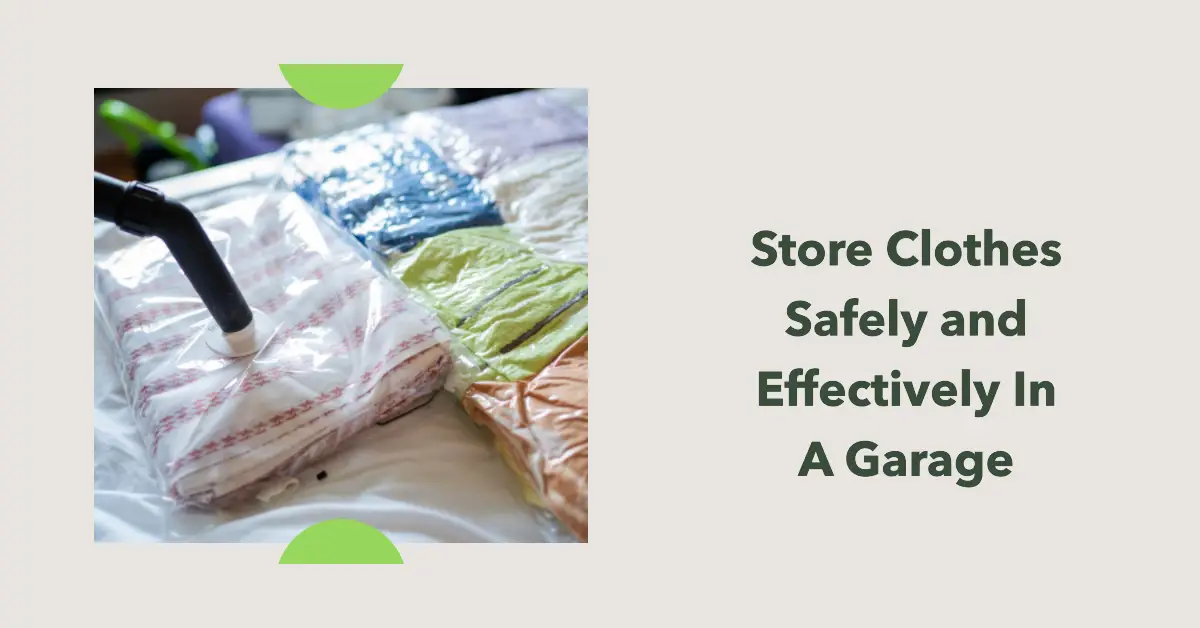I am a well-rounded expert with proficiency in several fields. My experience spans from being a dedicated chef and homemaker. As a passionate homesteader, I’ve honed my skills in sustainable living and animal care, ensuring a holistic approach to everything I undertake. Email me or Txt: (# removed due to spam, please email)
As someone who has faced the challenges of limited storage space at home, I know how crucial it is to utilize every available area to store your belongings, including the garage. But when it comes to storing clothes in a garage, there’s more to it than just finding a free corner.
To ensure your garments remain in top-notch condition, it’s essential to follow safe clothing storage practices. That’s why I’ve created this comprehensive guide to help you store your clothes safely in your garage.
In this informative article, I’ll share valuable insights into garage preparation, organization tips, preserving delicate items, and pest control measures.

Preparing the Garage for Clothes Storage
Before storing clothes in a garage, assess the available space and organize the area to maximize efficiency. Ensure the garage is well-insulated and ventilated to prevent moisture and temperature fluctuations that could damage your clothing.
Take proactive pest control measures and install appropriate lighting to create a safe and functional storage environment.

Choosing the Right Storage Solutions
Proper storage of clothes is essential for maintaining their quality and longevity. When it comes to storing clothes in your garage, choosing the right storage solutions is crucial to protect them from dust, moisture, and pests. Here are some factors to consider when selecting the best storage options for your needs:
- Plastic Bins: Plastic bins are a popular and affordable option for storing clothes in the garage. They are available in various sizes and shapes, making them versatile for different types of clothing. However, plastic bins are not breathable and can trap moisture, leading to mold and mildew growth. Consider adding moisture-absorbing packets to the bins to prevent excess moisture.
- Vacuum-Sealed Bags: Vacuum-sealed bags are a space-saving solution for storing clothes in the garage. They compress clothing and create an airtight seal to protect them from dust, insects, and moisture. However, vacuum-sealed bags are not suitable for all types of clothing, especially those that require hanging, as they can cause wrinkles and damage.
- Hanging Garment Racks: Hanging garment racks are ideal for storing dresses, suits, and jackets that need to be hung to maintain their shape. They are available in various sizes and styles and can be easily moved around the garage. However, hanging garment racks can take up significant space and may not be suitable for small garages.
- Shelving Systems: Shelving systems are a versatile storage option for folded clothing, such as sweaters and jeans. They come in various sizes and can be easily customized to fit your garage’s layout. However, they can also take up significant space, and clothes on shelves may be susceptible to dust and other pollutants.
Factors to Consider
When choosing the right clothes storage solution for your garage, consider the following factors:
- Type of clothing you’ll be storing
- Frequency of use
- Space constraints in your garage
- Material of the storage solution
- Moisture and pest control features
- Accessibility
By selecting storage solutions that offer breathability, moisture control, and pest protection, you can ensure your clothes stay in good condition.
Consider the type of clothing you will be storing, frequency of use, and available space in your garage when selecting the best storage solutions for your circumstances.

Proper Clothing Organization Techniques
Additionally, consider the layout of your garage and plan your clothing storage accordingly. For example, if you have a high ceiling, utilize overhead storage solutions to free up floor space.
If you have a narrow garage, opt for hanging garment racks or narrow shelving units to maximize storage capacity without taking up too much space.
Another useful clothing organization technique is to rotate your clothes based on the season or occasion.
This ensures that you only have relevant items taking up space in your garage, while the rest are stored away until needed. Additionally, consider using garment protectors or covers to prevent dust and damage to your clothes while in storage.
Properly organizing your clothes in the garage can also help you maintain an inventory of what you have, making it easier to keep track of what needs to be replaced or restocked.
This can be particularly helpful when planning seasonal wardrobe changes or preparing for special occasions.
Remember to also regularly declutter your clothing storage to prevent overcrowding and maximize space. Donate or discard items that are no longer needed or are damaged beyond repair to keep your storage area organized and clutter-free.
Pro Tip: A useful tip for maintaining an organized clothing storage system is to set aside a specific day every six months to a year to sort through your clothes and donate items you no longer wear or need. This regular assessment can help prevent clutter buildup and ensure that your storage space remains efficient.

Preserving Delicate and Valuable Garments
Preserving delicate and valuable garments is essential for maintaining their quality and prolonging their lifespan. Here are some tips for proper storage:
- Proper Handling: Handle delicate items with clean hands to prevent stains and damage. Avoid using sharp objects that can tear or puncture the fabric.
- Cleaning: Clean garments before storage to remove any dirt, stains, or odors that can attract pests or cause discoloration. Always follow the manufacturer’s care instructions or consult a professional cleaner for specialized items.
- Appropriate Storage Materials: Use acid-free tissue paper to stuff sleeves and maintain the garment’s shape. Avoid plastic bags or containers, which can trap moisture and promote mold growth. Instead, opt for breathable fabric garment bags or storage boxes made from natural materials like cotton or linen.
- Storage Environment: Store delicate items in a cool, dry, and dark environment to prevent discoloration and avoid exposure to direct sunlight, which can cause fading. Avoid storing them in attics or basements where temperature and humidity levels fluctuate.
In addition to these general tips, here are some specific recommendations for certain types of delicate and valuable garments:
- Fur and Leather: Store fur and leather garments in a cool, dark, and well-ventilated environment. Avoid hanging them, as the weight can damage the fibers. Instead, store them in a flat position in a temperature-controlled storage unit.
- Silk: Silk should be stored in a cool, dry, and dark place, away from direct sunlight. Avoid using metal hangers, which can leave rust stains on the fabric, and opt for padded hangers instead.
- Vintage and Heirloom Items: Consider using acid-free boxes or archival storage materials specifically designed for vintage and heirloom items. These specialized storage solutions can protect delicate fabrics and prevent damage caused by light and moisture.
Pro Tip: It’s important to note that not all garments are suitable for vacuum-sealed bags as some delicate or puffy items, such as down jackets or puffy dresses, can become flattened and lose their shape. Consider using other storage methods such as hanging or folding for these items to preserve their quality.

Moisture Control and Prevention
Identify potential sources of moisture in your garage and take steps to address them. Use desiccants or dehumidifiers to maintain optimal humidity levels and prevent mold, mildew, and odors from affecting your clothes.
Ensure proper ventilation in your garage by installing vents or fans to allow air to circulate and prevent moisture buildup.
Avoid storing clothes in damp or wet conditions and be sure to dry them thoroughly before placing them in storage containers.
Using moisture-resistant storage solutions, such as plastic bins with tight-fitting lids or vacuum-sealed bags, can also help protect your clothes from moisture damage.

Temperature Considerations
Extreme temperatures can harm clothing, so insulate your garage and monitor the temperature to maintain a stable environment. Make adjustments as needed to ensure your garments are stored at a safe temperature.
In addition to insulation and temperature monitoring, it is also important to avoid storing clothes in direct sunlight or near heat sources, such as heaters or vents.
High temperatures can cause fading, yellowing, and even melting of certain fabrics. Storing clothes away from windows and heat sources can help prevent damage from temperature fluctuations.

Preventing and Addressing Pest Infestations
Be proactive in preventing pest infestations in your garage. Regularly inspect your storage area for signs of pests and take appropriate measures to eliminate them if necessary.
Use pest-resistant storage solutions, such as sealed plastic bins, to prevent pests from entering and damaging your clothes. Consider using natural pest deterrents, like lavender sachets or cedar balls, to keep pests away.
If you do encounter a pest infestation, take immediate action to eliminate the problem and thoroughly clean your storage area to prevent future occurrences.

Seasonal Clothing Storage Tips
Transition your wardrobe between seasons by storing out-of-season garments in the garage. Follow specific storage guidelines for winter and summer clothing to maintain their quality during storage.
Proper storage of seasonal clothing is essential for preserving their quality and ensuring they are ready to wear when the weather changes. Here are some tips for storing winter and summer clothing in your garage:
Summer Clothing Storage Tips:
- Wash and dry your summer clothes before storing them to prevent stains and odors from setting in.
- Fold and store summer clothes in plastic bins or hanging garment bags to protect them from dust and pests.
- Label the storage containers with the specific items and categories to make it easy to find them when you need them.
- Store the containers in a cool, dry place in your garage.
Winter Clothing Storage Tips:
- Wash and dry your winter clothes before storing them to remove any dirt or stains.
- Use vacuum-sealed bags to compress winter clothing and save space.
- Store winter clothes in plastic bins or hanging garment bags to protect them from dust and pests.
- Label the storage containers with the specific items and categories to make it easy to find them when you need them.
- Store the containers in a cool, dry place in your garage.
By following these tips, you can keep your seasonal clothing organized and in good condition, ready to wear when you need them.

Maintaining Clothing Quality During Long-Term Storage
Periodically inspect your stored clothes and perform maintenance tasks as needed to keep them in excellent condition. Refresh garments before use to ensure they look and feel their best.
Here are some additional tips for maintaining clothing quality during long-term storage:
- Clean and dry your clothes thoroughly before storing them to prevent the growth of mold and mildew.
- Fold your clothes properly to avoid creases and wrinkles. Avoid hanging heavy garments for extended periods, as they may stretch and lose their shape.
- Use acid-free tissue paper to separate delicate fabrics and prevent color transfer.
- Avoid storing clothes in direct sunlight, as it can fade colors and weaken fibers.
- Check your clothes regularly for signs of damage or wear, and repair them promptly to prevent further damage.
- Consider adding natural repellents like lavender sachets or cedar blocks to your storage containers to discourage pests and keep your clothes smelling fresh.

Maximizing Garage Storage Efficiency
In addition to selecting the right clothing storage solutions, it’s essential to maximize your garage’s storage efficiency to ensure that you have enough space to store all of your belongings.
- Utilize vertical storage: Take advantage of wall space by installing shelving units, pegboards, or hooks to keep your items off the floor and easily accessible.
- Use unused spaces: Look for unused spaces such as the ceiling or the area above the garage door to install additional shelving or storage units.
- Invest in multipurpose storage solutions: Consider investing in storage solutions that can serve multiple purposes, such as a storage ottoman that doubles as a seating area or a bed with built-in drawers for added storage.
- Group similar items together: Organize your belongings by category to make it easier to find what you need quickly.
- Label your storage containers: Use clear storage containers and label them to simplify the inventory management process and ensure easy access to your belongings when needed.

Safety Precautions
Practice proper lifting and handling techniques to prevent injuries while managing your clothing storage. Observe fire safety measures and ensure safe access to stored items at all times.
In addition to practicing proper lifting and handling techniques, ensure that heavy items and storage containers are stable and secure to prevent accidents. Keep flammable materials away from heat sources and install smoke detectors in the garage to reduce the risk of fire.
Lastly, make sure your storage solutions are easily accessible, and avoid stacking heavy containers too high to prevent them from toppling over.

Conclusion
By following the expert advice in this comprehensive guide, you can store clothes in a garage safely and effectively. Implement these best practices to protect your garments and maintain their quality while they’re stored in your garage. With proper planning, organization, and maintenance, your clothes will remain in excellent condition for years to come.



